IJCRR - 13(16), August, 2021
Pages: 144-150
Date of Publication: 30-Aug-2021
Print Article
Download XML Download PDF
Effectiveness of Assertive Training Program on Knowledge Regarding Prevention of Abuse among Adolescents
Author: Sharma Jigyasha, Kaur Ravneet, Kaur Kawaljit
Category: Healthcare
Abstract:Introduction: Abuse is the use of some bad words or treating someone other with harmful treatment that includes mental, physical, sexual, verbal or intellectual maltreatment. Adolescence is the transition age group that includes major changes in life such as social, mental, physical and emotional changes. Thus, the girls are more prone to such conditions and need to be assertive in those particular situations. Assertive training is the procedure of acquiring skills within self and standing for the rights of one's own. The assertiveness training program should be used and taught to adolescent girls as it can help in improving their social skills, self-esteem and concept. Objective: The primary objective of the study was to assess the effectiveness of assertive training programs on knowledge regarding the prevention of abuse among adolescent girls. Methodology: The study setting was MHR DAV Institute of Nursing, Jalandhar, Punjab. A one-group pre-test post-test design was employed to get data collected. The study sample comprised of 100 adolescent girls who are selected through a purposive sampling technique from the selected nursing institution. A self-structured knowledge questionnaire was used to evaluate the knowledge regarding the prevention of abuse among adolescent girls. Assertive Training Program was prepared and administered to the adolescent girls. Results: The findings of the study revealed that after the administration of the Assertive Training Program majority of the adolescent girls 67 (67%) were having average knowledge regarding prevention of abuse among adolescent girls. The mean difference between pre-test and post-test knowledge was 6.06 and the calculated value (11.23) was found to be statistically significant. Conclusion: The study concluded that after the administration of the Assertive Training Program highly significant difference was found between pre-test and post-test knowledge scores regarding prevention of abuse among adolescent girls which was evaluated by a self-structured knowledge questionnaire.
Keywords: Assertive Training Program, Abuse, Effectiveness, Prevention of Abuse, Knowledge, Adolescent girls
Full Text:
Introduction
Abuse is inappropriate behaviour and harmful treatment that influences many populations throughout the world. It is the inappropriate use or treating of the person who is often done by the abuser to unwarranted or inappropriate profit. It classified abuse in many types, such as physical maltreatment, verbal maltreatment, assault, violation, rape, or eve-teasing. A great deal of maltreatment is unavoidable and only can be escaped once they take place. Eve-teasing and sexual abuse are two types of abuse.1 Eve-teasing is the making of unwanted sexual remarks in public places 2 and sexual abuse is sexual behaviour acted upon without consent 3 Assertive training is the program that is used to modulate the behaviour of the person and stand for their rights in the right way. It helps in empowering themselves, interacts equally with every person in society, and creates a positive sense of one. It also increases the respect for self and others. The principal aim of assertiveness training is to teach the person about using social skills in social gathering and recognizing the needs and outcomes for the communication.4
The world health organization estimates that according to worldwide health statistics, 879,000 adolescents have experiences with sexual abuse.5 According to a census, in the world, the maximum number of adolescents i.e. 375 million are living in India and these are covering 40% of India’s total population. Out of this 40% of the population, 69% of adolescents are the victim of different abuse like physical, emotional, and sexual abuse.5 According to a report released in 2016 on criminal offenses in New Delhi, India presented by the former Home Minister of India Rajnath Singh, 1,06,958 cases were reported about the crimes for adolescents in the year 2016. Out of these, 36,022 cases were reported for sexual abuse and the reason was neglect and unable to discuss. 6According to a study conducted on sexual abuse, One-third of the total sample collected had experienced anyone type of abuse sexual abuse. The study also reported gender differences in preferences of sexual abuse.7
Objectives
-
To assess the pre-test knowledge regarding prevention of abuse among adolescent girls.
-
To plan and implement the assertive training program regarding the prevention of abuse among adolescent girls.
-
To assess the post-test knowledge regarding prevention of abuse among adolescent girls.
-
To compare the pre-test and post-test knowledge regarding prevention of abuse among adolescent girls.
-
To determine the association of knowledge regarding prevention of abuse among adolescent girls with their selected socio-demographical variables.
Related work:
Patel V et al. conducted a research study in Goa, India on adolescents on sexual abuse and risk behaviours among adolescents. The study was conducted among 12-17 years of adolescents. A total of 811 adolescents were selected and among them 53% were males and 47% were females. The findings revealed that one-third i.e. 266 adolescents had experienced some type of sexual abuse. Out of those 266 adolescents, 47% of adolescents had experienced sexual abuse more than a single time. Gender contrasting was also seen in the types of sexual abuse recorded in the study. There are also differences found in the risk behaviours’ of urban-rural school students. The risk behaviours were found for the students from older students or friends was maximum i.e. 53%, 8% for relatives, 4% of teachers and miscellaneous were 27%. The final findings showed that increased rates of sexual abuse are because of low awareness. 7
Anderson J et al. conducted a research study to find out the prevalence of sexual abuse among children and the nature of sexual abuse in childhood. The research design was used using a two-stage design in which one is with the help of a questionnaire and the other is the face-to-face interview. The sample provided general information on different aspects like prevalence rates, types of abuse, age of the victim, and relation of the abuser with victim and cohort effects. The results revealed that one-third of women in the study i.e. a woman in every three women having one or more times undesirable or forced sexual experiences. The results also revealed that a total of 70% were involved in genital intercourse or other more severe abuse, 12% of them were having sexual intercourse. The results also showed that the majority of the offenders were young men. The prevalence rates also showed that there are no urban or rural differences among samples with their age groups. 8
Kathleen B et al. carried out a research study in the United States on childhood sexual abuse by family members. The study aimed to assess that if a woman is sexually abused as a child in her own family had also experienced more childhood abuses in other forms like physical abuse as compared to the women who had experienced physical abuse. The sample includes 60 females who were not sexually abused and 89 females who were sexually abused in their own families. The study showed that the sexual abuse-related factors and violence in the family members of the victim must be contemplated for the individuals and strategies to stop the potential crimes by experienced individuals. 9
Carry PD et al. conducted a cross-sectional study in South Africa on risk indicators and psychopathology in traumatized children and adolescents with any history of sexual abuse. The study sample showed the results about risk indicators in traumatized children and the most prevalent psychological after-effects of trauma. The total sample selected was 94 and those were selected as who are exposed to any trauma in their life. The final results of the study showed that increased rates in child sexual abuse are indicating higher rates of post-traumatic stress disorders in the selected traumatized samples. 10
Nwadinobi V conducted a study for assessing the role of assertiveness training programs for the prevention of non-consensual sexual experiences and abuse. The total study sample in the research study was 50 girls. The study indicated that 6 sessions were administered among 50 girls. The findings revealed that there is a significant improvement in the knowledge that non-consensual sexual abuse is a legal issue. 11
Abraham S conducted a quasi-experimental study of the management of sexual harassment through assertiveness skills. The study consisted of 150 adolescent girls. The findings revealed that the majority of adolescent girls have some form of sexual harassment experience. There is a slight change in assertiveness level after intervention as well as a change in management of sexual harassment skills.12
Lobo L conducted a research study on the relationship of sexual abuse knowledge with assertiveness skills and self-confidence among young adolescent girls. The study consisted of the four selected high schools in Mangalore city. The sample size was 100 respondents i.e. 25 girls of age group 13-15 years from each school. The research study concluded that nearly half of the girls were having poor knowledge. The findings also revealed that there is a significant increase in the knowledge of the girls with increasing assertiveness scores.13
Dzimadi R had undertaken a study to evaluate the knowledge of sexual abuse among female adolescents in Malawi. A total of 219 samples were selected from systematic random sampling. The results showed that 41% of sexual abuse was prevalent in the selected sample, 55.6% reported the sexual abuse, 44.4% of the total sample were silent about their experiences. 27.8% of the total sample had told about sexual abuse to their friends, 16.7% of them had told to their mothers, 7.8% of them told to other family members including sisters, aunt’s etc.14
Amole K ascertained a study to know the impact of assertive training programs among nurses. The study findings revealed that a highly significant difference was noticed between before and after training programs regarding the practice of communication skills, assertiveness and self-esteem. 15
Makinde OB et al. undertook a study to evaluate the effects of assertiveness training on self-esteem in Lagos secondary schools. The sample selected was a total of 96 adolescents i.e. 48 males and 48 females from schools. The research design was quasi-experimental with a pre-test post-test control group method was undertaken. Two tools are used to find the final results for the study. The findings concluded that assertiveness training and mentoring were quite effective for increasing self-efficiency. The study also concluded that there was no association between religion and the educational status of parents with assertiveness training and mentoring. 16
Material and methods
Ethical clearance was taken before conducting the study from the ethical committee of MHR D.A.V Institute of Nursing, Jalandhar. The reference number of the ethical committee approval letter is 8A/39.
This pre-experimental research design was conducted at MHR DAV Institute of Nursing, Jalandhar, Punjab. The sample was adolescent girls studying in B.Sc. (N) 1st and 2nd year and those who are interested to attend the data collection procedure.
Research approach: Quantitative research approach was contemplated and found appropriate for the study.
Study design: Pre-experimental research design with one group pre-test post-test method was used in the study.
Study Location: The study was carried out in a nursing institute based in Jalandhar, Punjab at MHR DAV Institute of Nursing.
The sample size was 100 adolescent girls studying in B.Sc. (N) 1st and 2nd year.
Sampling technique: The technique to draw the sample used was Non-probability purposive sampling.
Methodology
Development of tool:
Part I: - Socio-demographic variables: The variables to find out the personal information of subjects on aspects like age, residential area, currently residing in, type of family, father and mother’s education and occupation and previous source of knowledge regarding prevention of abuse.
Part II: - Self-structured knowledge questionnaire to evaluate the knowledge regarding prevention of abuse.
Data collection procedure
Final data were collected after getting administrative acquiescence. The aim of the research was described to the sample and was assured regarding anonymity and confidentiality of the data given by them, and informed consent was obtained to engage in the investigation.
Pre-test: Pre-test was administered to adolescent girls in the form of a structured knowledge questionnaire on the prevention of abuse.
Implementation of Assertive Training Program: The assertive training program was administered (Figure 1) on the same day of the pre-test to adolescent girls.
Post-test: Post-test was carried out on the 3rd day of pre-test with the same set of structured knowledge questionnaires on prevention of abuse.
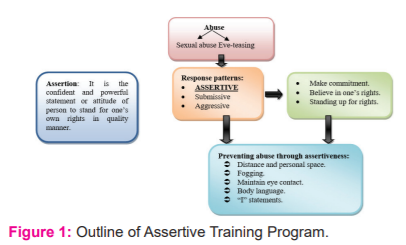
Statistical analysis
Data were analyzed using inferential and descriptive interpretation. Interpretation and evaluation of data were performed employing percentage, mean, and mean percentage, standard deviation, chi-square and paired t-test. Paired t-test was performed to ascertain the significant differences between mean pre-test and mean post-test values. Chi-square was employed to know the association of knowledge with selected socio-demographic variables.
Results
Description of socio-demographic variables
Most of the adolescent girls i.e. 68% are in the age group of 19-20 years, 47% of adolescent girls are residing in urban areas, majority of adolescent girls i.e.75% are currently residing in a hostel, 78% of adolescent girls are belonging to the nuclear family, 62% of adolescent girls are having previous knowledge about prevention of abuse from media, 38% of adolescent girl’s fathers are having education up to 11th to 12th, 36% of adolescent girl’s mothers are having education of graduate or above, 36% of adolescent girl’s fathers are a government employee and 82% of adolescent girl’s mothers are home-maker.

Maximum score = 30 ***Significant at 0.001 level
Minimum score = 00 df=99
The mean pre-test knowledge score was 13.90 (±4.56) and mean of post-test knowledge score was 19.96 (±3.26) (Figure 2). The findings revealed that mean difference between pre-test and post-test knowledge was 6.06. The calculated‘t’ value (11.23) was found to be statistically significant at 0.001 level of significance (Table 1). Hence, it revealed that the difference in the mean pre-test and mean post-test knowledge score regarding prevention of abuse was a true difference not by chance.
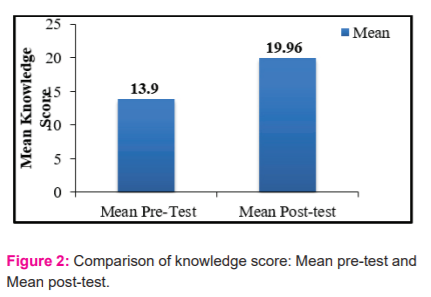
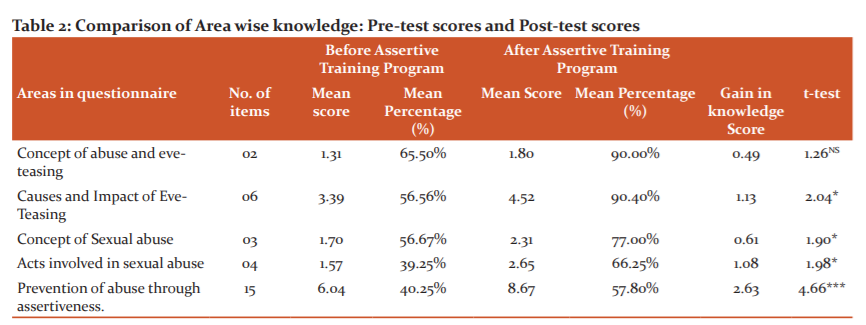
df = 99 * = Significant at 0.05 level
*** = Significant at 0.001 level NS= Non-Significant
The findings indicate the mean pre-test and post-test knowledge scores of different areas regarding prevention of abuse among adolescent girls.
It showed the total gain in the knowledge after an assertive training program in the concept of eve-teasing (0.49), causes and impact of eve-teasing (1.13), the concept of sexual abuse (0.61), acts involved in sexual abuse (1.08) and prevention of abuse through assertiveness (2.63) (Table 2) (Figure 3).
The calculated t-test for the concept of abuse and eve-teasing is 1.26 which is not found significant, concept and impact of eve-teasing is 2.04 which is significant at the level of 0.05, the concept of sexual abuse is 1.90 which is found significant at 0.05 level, acts involved in the sexual abuse is 1.98 which is also significant at 0.05 level and prevention of abuse through an assertive training program is 4.66 which is highly significant at 0.001 level (Table 2)
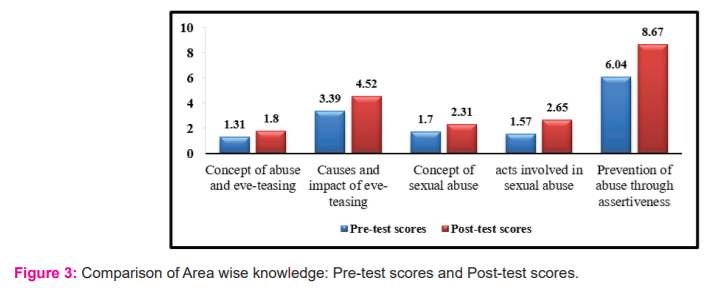
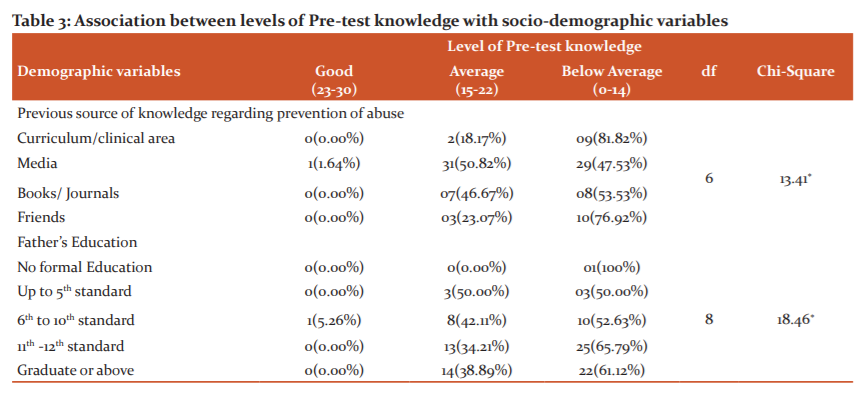
It is concluded from the association scores with pre-test knowledge that socio-demographic variables like the previous source of knowledge and father’s education influenced the knowledge of adolescent girls on prevention of abuse. (Table 3)
Discussion:
Assessment of the pre-test knowledge:
The analysis of the first objective showed that in the present study, the mean pre-test knowledge score was 13.90. As per the level of knowledge more than half of the adolescent girls i.e. 53 (53%) were having below-average knowledge regarding prevention of abuse. These same findings are found in the study that the maximum number of adolescent girls were having below-average knowledge regarding prevention abuse before intervention17.
Assessment of the post-test knowledge:
The analysis of the objective showed the major findings of the mean post-test knowledge score was 19.96. As per the level of knowledge most of the 67 (67%) adolescent girls were having average knowledge regarding prevention of abuse. The study of other investigators revealed the same findings17. The research was conducted on 207 student nurses from four different grades. The study findings revealed that 60.4% of students were having increased post-test scores.
Compare the pre-test and post-test knowledge:
The analysis of the objective showed that after the administration of the Assertive Training Program there was a significant increase in post-test knowledge scores among adolescent girls, which was statistically significant at 0.001 levels. The findings are similar to the study conducted in Nigeria in high school with 174 high school girls18. Two different sets of questionnaires were used, one on self-efficacy and the other on sexual assertiveness. The outcome was found that there was a significant increase in sexual assertiveness scores. The investigator found that the program was effective for the sexual assertiveness of high school girls.
Association of socio-demographic variables with knowledge scores:
The findings in the objective revealed that the association of pre-test knowledge score with their selected socio-demographic variables i.e. previous source of knowledge regarding prevention of abuse (13.41) and father’s education (18.46) was statistically significant at p<0.05 level.
The findings are similar to a study investigated previously on the knowledge regarding abuse among adolescent girls. 60 adolescents were drawn from educational institutions through purposive sampling. The findings showed that the father’s education of adolescent girls has a significant effect on knowledge regarding the prevention of abuse16.
The above findings are consistent with a study that investigated the effects of Mentoring and Assertiveness Training on Adolescents’ self-esteem in Lagos State secondary schools. A total of 96 adolescents (48males and 48 females) drawn from three public schools randomly selected from three Education Districts in Lagos State constituted the final sample. The findings showed that previous knowledge regarding the prevention of abuse has a significant effect in raising adolescent’s knowledge19.
Recommendations:
-
A similar study can be done with a larger sample and different settings i.e. community settings to extrapolate and vindicate the findings
-
A comparative study can be ascertained to evaluate the knowledge about abuse and its prevention amid of early adolescents and late adolescent girls in selected schools.
-
A similar study can be done to assess the effectiveness of video-assisted teaching programs on knowledge regarding the prevention of abuse among adolescent girls.
Conclusion:
Sexual abuse and eve-teasing are quite common and increasing day by day among adolescent girls. Some of the cases remain unreported in some areas. So, the use of proper skilful training is needed to educate and empower them. The findings also reported that there is an increase in knowledge of adolescent girls after the assertive training program as measured by the self-structured knowledge questionnaire. The findings should be used in practice to assess the knowledge and assertiveness among adolescents. Furthermore, professional nurses can use the techniques of assertiveness in different fields. Senior Nurses can guide the nursing staff about assertiveness; it will help in upgrading their knowledge and skill which can be utilized appropriately. Administrators can organize in-service education programs to improve self-esteem and awareness about abuse among staff.
Acknowledgement:
I acknowledge the immense help received from the scholars whose articles are cited and included in references of this manuscript. I am also grateful to authors/editors / publishers of all those articles, journals and books from where the literature for this article has been reviewed and discussed.
Conflict of interest: We acknowledge that there is no conflict of interest in this paper.
Author contribution: Jigyasha Sharma conceptualized the thought, designed this study, and revised the manuscript. Ravneet Kaur and Kawaljit Kaur prepared for ethical permission and data assemblage of the study. Jigyasha Sharma picked up the role in data analysis, Ravneet Kaur and Kawaljit Kaur evaluated the data gathered and interpreted. All authors reviewed and proofread the final manuscript before submission for publication.
Funding: This research was conducted and funded by personal contribution. No external funding got.
Ethical approval: Ethical approval was obtained from the MHR DAV Institute of nursing research Committee with approval number 8A/39. Consent was also taken from the participants.
References:
-
Alberti R, Emmons M. Your Perfect Right: Assertiveness and Equality in Your Life and Relationships. 8th ed. Atascadero, CA: Impact Publishers; 2001.
-
Barrett, Grant.Eve-teasing, McGraw-Hill Professional; 2006.
-
American Psychological Association. Sexual abuse[document on internet].2018. Available from: https://www.apa.org/topics/sexual-assault-harassment
-
Kathleen D. Bauer, Doreen Liou, Carel A. Sokolich. Nutrition Counselling and education skill development. Cengage Learning; 2004.
-
Gupta N, Aggarwal NK. Child abuse. Delhi Psychiatric J. 2012 Oct;15(2):416.
-
Payne A. Wayne, Dale HB. 3rd ed. Understanding your health. Indiana: Mosby Yearbook; 1992: 148-52.
-
Patel V, Andrew G, Gender and sex abuse and risk behaviors in adolescents. A cross-sectional survey in schools in Goa. Nat Med J India. 2001;14:263–7.
-
Anderson J, Martin J, Mullen P, Romans S. Prevalence of childhood sexual abuse experiences in a community sample of women. J Am Acad Child Adolesc Psych. 1993 Sep;32(5):911-9.
-
Kathleen B, Ann W. Childhood sexual abuse by a family member, salivary cortisol and homicidal behaviour of female prison inmates. Nurs Res. 2008 May;57(3):166-74.
-
Carey PD, Walker JL, Rossouw W, Seedat S, Stein J. Risk indicator and psychopathology for traumatized children and adolescent with a history of sexual abuse. 2008 Mar;17(2):93-8.
-
Nwadinobi V. Effects of Assertiveness Training and Child assault preventive program on prevention of non-consensual sexual experiences and abuse.2019 Sep.
-
Abraham S. Management of sexual harassment through assertiveness skills. J social work edu pract Int Peer Rev J. 2016; I(I):81-97. https://www.jswep.in/uploads/3/1/7/2/31729069/management_of_sexual_harassment_through_assertiveness_skills.pdf
-
Lobo L. Sexual abuse knowledge and its relationship with self-confidence and assertiveness skills among young adolescent girls. Int J Sci. Study 2018 Sep;7(9):42-6.
-
Dzimadi R, Klopper H. Knowledge of sexual abuse amongst female students in Malawi. Curation. 2007 Sep;30(3):23-30.
-
Kanade A. The effects of an assertiveness training program on nurses. Indian J Psych. 2018; 15(2):19-23.
-
Makinde OB, Akinteye AJ. Effects of Mentoring and Assertiveness Training on Adolescents’ Self-Esteem in Lagos State Secondary Schools. Int J Soc Sci Res. 2014 Jun;2(3):78-88.
-
Slater J. Effecting personal effectiveness: assertiveness training for nurses. J Adv Nurs. 1990 Mar;15(3):337-56.
-
Agbakwuru C. Effect of assertiveness training on resilience among early-adolescents. Euro Sci J. 2010 May;8(10):69-84
-
Kaur Sumanpreet. Effectiveness of structured teaching program on knowledge regarding sexual abuse. Int J Nur Edu. 2017; 5(1):33-43.
-
Correlation between Mental Well-Being and Decision Making Competency (Dmc) Among Early Adults. Eur J Mol Clin Med. 2021; 8(2):892-902.
|






 This work is licensed under a Creative Commons Attribution-NonCommercial 4.0 International License
This work is licensed under a Creative Commons Attribution-NonCommercial 4.0 International License